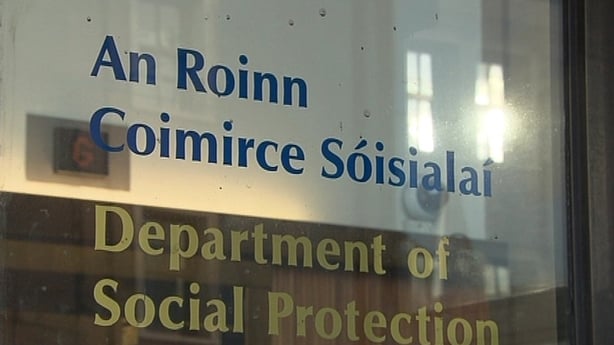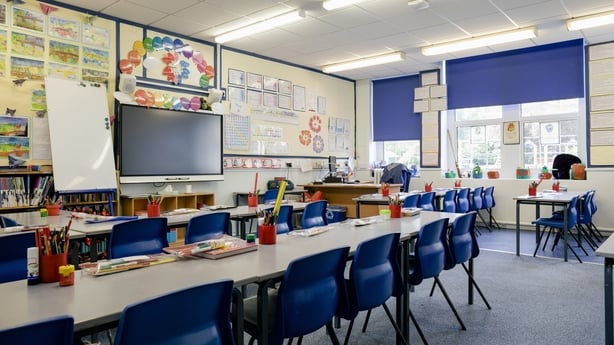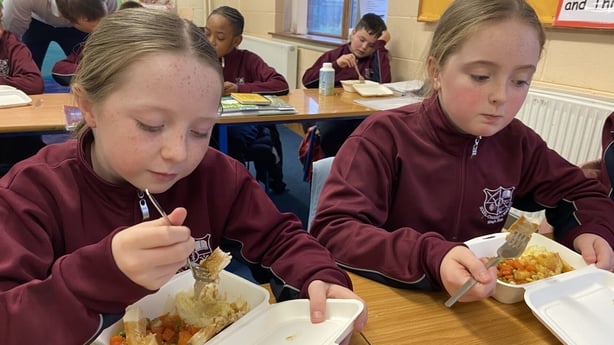World
The nutritional challenge facing Hot School Meals scheme

Can I have six curries, one taco and one roast chicken?” Brenda Gardiner calls out across the kitchen of St Munchin’s Community Centre in north Limerick city.
It’s 11am and it’s “all go”.
At the centre, 12 workers are beavering away, calling to each other, filling individual containers of food from big steel pots, packing the containers into hot boxes, mashing spuds, frying chips and washing up.
Every school weekday this kitchen prepares almost 600 hot meals for children in two primary schools in the city – CBS Sexton Street across the city and Corpus Christi Primary School in nearby Moyross – as part of the State’s Hot School Meals programme.
It is a social enterprise and also prepares meals on wheels for elderly people locally.
All of the food is sourced locally and all of the meat is Halal.
At 8am, an array of vegetables is spread across the work surface including carrots, sweet potatoes, beetroot, garlic, ginger, peppers, spinach and more.
All of these – plus apples, dates and chickpeas – are roasted and blitzed to make the centre’s special “pink sauce”.
It’s their secret ingredient, chef Clodagh Dunworth explains.
Mr Dunworth said: “I’m trying to sneak the veg in. I have kids myself and I know they can be picky.
“So we cut everything down, tray it up, olive oil onto it, then into the ovens and bake it to get all of that natural sweetness out of the veg.
“Then I blitz it down as much as I can. There’s no salt or sugar in the sauce, it’s all sweetened by your apples, your dates.
“I also put in plant-based protein like chickpeas or red kidney beans. I’m trying to get the most out of this sauce without the kids knowing.”

The two schools that this kitchen serves are among more than 500 primary schools nationally that are currently receiving hot school meals paid for by the State.
In April, an additional 900 primary schools became eligible.
By 2030, the programme will reach every school in the county. At least that is the plan.
The programme forms part of Ireland’s commitment under the European Child Guarantee to give all children access to a range of key services, including healthcare and nutrition. Under the guarantee, Ireland committed to ensuring by 2030 that all children receive at least one healthy meal each school day.
The Hot School Meals Programme is popular with many principals, parents, and pupils. But its impact is hard to measure.
An independent evaluation published last year by the Department of Social Protection found that it had “partially achieved” its primary objective – to provide regular nutritious food to children.
Using three key indicators – better diet, increased school attendance, and improved educational attainment – it said it had uncovered evidence of numerous benefits. “However”, it stated, “we are unable to offer any comprehensive long-term evidence about these outcomes (better diet, increased attendance, improved educational attainment) as neither the Department of Social Protection nor the Department of Education have been systematically collecting and collating relevant data to allow us to state with confidence that the School Meals Programme is as effective as it can be”.
Peppered throughout the literature relating to the scheme are words like “healthy” and “nutritious”.
But there is some concern about the standard of some of the food on offer.
The evaluation report recorded “skepticism, especially among parents”, that nutritional requirements were actually being met, “despite the existence of nutritional guidelines and quality protocols with which school meals must comply”.
“Whilst schools are responsible, in conjunction with their suppliers for ensuring the nutritional requirements are being met”, it continued, “there was little evidence to suggest that there was a comprehensive system in place for inspecting these issues on the ground”.
Primary school teacher Shaun Conaghan is among those with concerns.
Currently completing a PhD in the subject, Mr Conaghan is passionate about nutrition and healthy eating.
When Minister for Social Protection Heather Humphreys wanted a location to announce a planned expansion of the school meals programme from, her department chose Mr Conaghan’s classroom.
This was over a year ago and back then he was wary about the programme, but hopeful too.
Mr Conaghan is less optimistic now and said his initial concerns about the nutritional quality of the food on offer from some suppliers have grown.
The teacher’s school receives food from one of several larger suppliers. As is the case in most schools because there are no canteen facilities and so, the food arrives in containers packed into hot boxes.
He said the nutrition standards laid down for the scheme are being flouted on a daily basis.
Some teachers in other schools, including those who use another large supplier, agree with him.
“During the school day children are being provided with some of the exact foods that we know are driving poor health outcomes and our obesity epidemic,” Mr Conaghan told RTÉ News.
He is concerned that children are getting a contradictory message.
“We are teaching them about healthy eating, but then we are serving up the exact foods that we are encouraging them to avoid,” he said.

Under the scheme, parents choose food for their child every week from a menu which contains a range of options that are offered by the company or enterprise that supplies their school.
Last month, the Department of Social Protection wrote to schools availing of the scheme, and reminded them of the nutritional standards that food provided under the programme must adhere to.
Quoting from those standards schools were reminded:”Processed meat or chicken products, fried foods, foods cooked in batter or breadcrumbs or food containing pastry, should only be provided once a week maximum, if at all”.
“For example, bacon, ham, sausages, chicken nuggets and similar products,” the letter continued.
Yet, from the menus provided by the company that supplies Mr Conaghan’s school, children/their parents are able to choose an ultra-processed option every day.
There are healthy options on the menus, but Mr Conghan said: “Ultra processed food is available every day including sausages, fish fingers, lasagna, carbonara, goujons and chicken fillet or chorizo pizza rolls.
“Breaded protein is available everyday”.
A teacher at another primary school, supplied by a different large school meals provider, showed menu choices made by her pupils/their parents to RTÉ News.
The menus from this second supplier also enable children/their parents to pick options such as sausages, chicken nuggets or fish fingers for their children to eat every day and the menu sheets show that they are doing just that.
The Limerick social enterprise too is supplying food that does not adhere to the standards.
RTÉ News has visited other schools too where children are offered ultra-processed food options more than the stipulated “once a week maximum, if at all”.
The Department of Social Protection confirmed to RTÉ News that “under the nutritional standards of the school meals programme, this is not permitted”.
The department told RTÉ News: “If any person or organisation, including RTÉ, has any concerns about the quality of food provided under the school meals programme in any specific school, they should be brought to the department’s attention and we will follow up accordingly.”
It said that “funding will not be provided for food that doesn’t comply with these standards”.
But in terms of who is responsible for policing adherence to the standards laid down by the State, the answer is not straightforward.
The Department of Social Protection said it “does monitor adherence to the standards including through site visits”.
The department told RTÉ News that it “also liaises directly with suppliers to ensure that they are aware of the standards required”.
But it said it is the schools’ responsibility to ensure that the standards are adhered to.
In its letter to schools last month, it reminded them of this: “Funding will not issue to schools for meals that do not meet the nutritional standards.”
“It is the responsibility of the school to ensure the food being served to the children is in line with guidelines,” it added.

This is a responsibility that schools are not all that happy with. School principals point out that they are educators not dieticians.
The Catholic Primary School Managers Association said schools are very conscious of the value of good nutrition “but are already facing an ever-increasing burden of regulation in their core activity of education without also having to police food suppliers as well”.
It has called for a vetting scheme for larger suppliers to ensure standards are maintained.
The industry that is supplying hot school meals to schools includes a number of large suppliers and a growing number of smaller companies, often operating at a local level.
Schools choose their own supplier.
Providers who spoke to RTÉ News acknowledge that there is work to be done to improve the nutritional content of the food that they offer, but they said it would be wrong to blame them for breaches of the standards.
It is a schools’ responsibility, one company said, to ensure that the menus and choices that a supplier offers comply with state guidelines.
Suppliers said the food choices on their menus are being driven by what schools and parents want.
“[Schools and parents] want to give children the food they will eat,” they said.
“If you are not providing that then you might not win the business or maintain the business,” they added.
“It is a balancing act,” said another, “if we were to switch [to healthier options] the entire program would fall over”.
The industry points to the fact that the scheme is still in its early stages, what one source called its “messy stage”.
Until now, one said, the primary focus was on ensuring children do not go hungry and on minimising waste.
Now, as the programme expands to non-DEIS schools they expect the nutritional content of the food on offer to come under more scrutiny.
Suppliers welcome this and said they are evolving and changing, with new and better menus coming on stream.
This is something that Mr Conaghan said can’t come too soon.
Pointing out that poor diet is now the number one driver of chronic disease worldwide, he outlined how the choices currently available to children in his school are falling short.
“For example, children selecting carbonara pasta combined with muffin and cream cracker snacks will have consumed up to half of the upper limit of their daily saturated fat intake with this small meal alone and 70% of their upper daily limit for saturated fat and salt,” he said.
The Irish Heart Foundation is also concerned about the quality of some of the food being provided under the Hot School Meal Programme.
It strongly supports the aims of the programme, but it believes the State needs to do more to ensure that food is low in saturated fats as well as sugar and salt.
“We are catching up [with other European countries], which is great, and the expansion of this program is a really important opportunity to get this right,” Orna O’Brien, dietitian with the foundation, told RTÉ News.
“We live in a very obesogenic environment with an onslaught of ultra-processed foods and one of the jobs of the scheme is to protect children from this onslaught,” she said.
Reviewing the menu offerings of one company, Ms O’Brien noted healthier options that meet nutritional standards but also ultra-processed choices that don’t.
“Including the less healthy options on the menu daily puts the more nourishing meals at a significant disadvantage,” she said.
Instancing a pepperoni pizza with potato “cubes” option, she said: “It’s human nature to crave high-fat, high-calorie food”.

Back in the kitchen of St Munchin’s Community Enterprise Centre the healthier option, the chicken curry, is a popular choice, but the less nutritious offerings such as chicken or fish goujons and potato wedges or chips are more popular still.
This social enterprise said it is striving to provide nutritious food for the children, but there is no point in providing healthy food if it ends up in the bin.
CEO of St Munchin’s Linda Ledger is critical of what she feels is a lack of State oversight of the Hot School Meals Programme on the ground.
“There is nobody checking,” she told RTÉ News.
This view is shared by other school meal providers.
They said that they are keen to see more inspections, more State oversight.
They have welcomed the fact that the Department of Social Protection has reminded schools of their obligation to ensure that the rules of the scheme are complied with, but one said they would like to see that reminder followed up with enforcement.
“If there are inspections and audits that creates a level playing field,” they told RTÉ News, “it means the businesses doing it properly will be recognised and rewarded”.

At Corpus Christi Primary School in Moyross the smallest children are the first to eat.
They eat breakfast altogether at tables in a common area, but lunch is eaten at their desks.
Within minutes Thomas O’Neill had devoured his tacos.
They contain mince in Clodagh’s secret sauce.
“A million out of ten,” Thomas said when asked to rate the food.
Thomas’s taco came with chips.
In 5th class, the chicken curry was a popular choice, but so too were the chicken goujons with mash or wedges.
In 2nd class, Amelia Duffy and Jamie O’Donnell were among those who chose the chicken curry.
“It’s really nice. It tastes like if you had normal chicken curry at home,” Jamie said.
But looking through the discarded boxes when lunch is over there’s a fair amount of chicken curry left over.
The chicken goujons and mash or wedges – the less healthy choices – have meanwhile been devoured.
The hot school meals programme is a significant public health intervention, its simple objective, to provide regular nutritious food to children.
As many parents will know, providing healthy food for children is often anything but simple. But that shouldn’t mean that it can’t be done.
As the hot school meals scheme expands, with up to 900 additional schools opting in over the coming academic year, a core challenge is to ensure that the rules that are supposed to restrict the choices parents and their children can make, actually achieve that aim.










